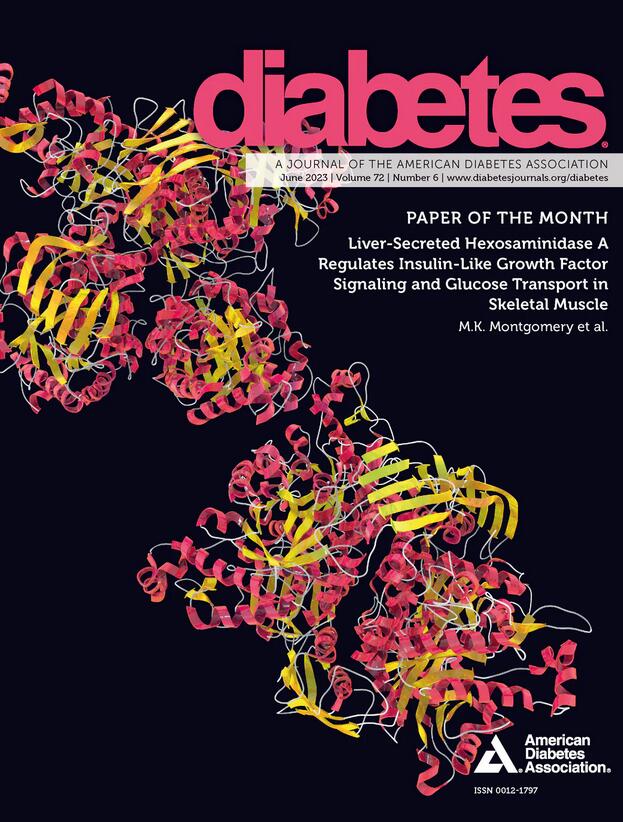332-OR: Multiomic Profiling of Extended Honeymoon Unveils New Therapeutic Targets
IF 6.2
1区 医学
Q1 ENDOCRINOLOGY & METABOLISM
引用次数: 0
Abstract
Introduction & Objective: Approximately 50% of patients with new-onset Type 1 Diabetes (T1D) experience a temporary recovery in pancreatic β-cell function, termed the "honeymoon" (HM) phase, lasting approximately 7-9 months on average, and only rarely extending to years. This phase provides a crucial window for interventions to preserve insulin secretion, yet the factors contributing to its occurrence remain unclear. This study presents the first comprehensive multi-omic profiling of children with new-onset T1D in an extended honeymoon phase (ExMoon), revealing potential molecular targets for preserving β-cell mass and function. Methods: Patients in ExMoon were defined by insulin dose-adjusted HbA1c (IDAA1c) below 9 and C peptide >300 pmol/l, sustained for at least 9 months. We conducted analyses of PBMC immunophenotype, immunoreactivity to islet antigens, serum secretomics, proteomics/metabolomics/lipidomics, and PBMC transcriptomics using flow cytometry, ELISpot, immunomagnetic separation, mass spectrometry, and RNA sequencing, respectively. Profiles of ExMoon patients were compared to age- and gender-matched patients with T1D not in the HM phase (n=10 per group), with 10 matched nondiabetic patients included as additional controls. Results: Differential serum levels of immune factors (IP-10, IL-2, FGF2), proteins (TGM2, SIR4), metabolites (kynurenine), and lipids (myristic acid and monoarachidonic acid triglyceride 18:0_38:6) were observed in ExMoon compared to the T1D group. PBMCs obtained from patients of the two groups exhibited distinct expression patterns of ERAP2, TSKS mRNAs, and of miR-339-3p, miR-8087-3p miRNAs. No differences were found in the proportion of immune cell subpopulations and islet autoreactivity between the ExMoon and T1D patient cohorts. Conclusion: Our unbiased multiomic approach identified several immune and non-immune factors as potential molecular candidates for targeted therapies aimed at preserving β-cell mass and function. Disclosure C. Loretelli: None. A. Gouda Abdelrahman Abdelsalam: None. M. Ben Nasr: Research Support; Altheia Sciences. V. Usuelli: None. E. Assi: None. M. Zocchi: None. A. Petrazzuolo: None. A. Petitti: None. G. Cannalire: None. F. D'Addio: None. C. Mameli: None. P. Fiorina: None. Funding Fondazione "Romeo ed Enrica Invernizzi"332-OR: 延长蜜月期的多组学分析揭示了新的治疗靶点
引言& 目的:大约 50%的新发 1 型糖尿病(T1D)患者的胰岛β细胞功能会出现暂时性恢复,即 "蜜月期"(HM),平均持续约 7-9 个月,只有极少数患者会持续数年。这一阶段为保护胰岛素分泌的干预措施提供了一个关键窗口,但导致这一阶段发生的因素仍不清楚。本研究首次对处于延长蜜月期(ExMoon)的新发 T1D 患儿进行了全面的多组学分析,揭示了保护 β 细胞质量和功能的潜在分子靶点。方法:胰岛素剂量调整后 HbA1c (IDAA1c) 低于 9 和 C 肽 >300 pmol/l,并持续至少 9 个月,即为 ExMoon 患者。我们分别使用流式细胞术、ELISpot、免疫磁分离、质谱和 RNA 测序对 PBMC 免疫表型、胰岛抗原免疫反应、血清分泌组学、蛋白质组学/代谢组学/脂质组学和 PBMC 转录组学进行了分析。将ExMoon患者的特征与年龄和性别匹配的非HM期T1D患者(每组10人)进行比较,并纳入10名匹配的非糖尿病患者作为额外对照。结果显示与 T1D 组相比,观察到 ExMoon 组血清中免疫因子(IP-10、IL-2、FGF2)、蛋白质(TGM2、SIR4)、代谢物(犬尿氨酸)和脂质(肉豆蔻酸和单花生四烯酸甘油三酯 18:0_38:6)的水平存在差异。两组患者的 PBMC 表现出不同的 ERAP2、TSKS mRNA 和 miR-339-3p、miR-8087-3p miRNA 表达模式。在免疫细胞亚群比例和胰岛自身反应性方面,ExMoon 组和 T1D 组患者没有发现差异。结论我们的无偏多组学方法确定了几种免疫和非免疫因素,它们是旨在保护β细胞质量和功能的靶向疗法的潜在候选分子。披露 C. Loretelli:无。A. Gouda Abdelrahman Abdelsalam:无。M. Ben Nasr:研究支持;Altheia Sciences。V. Usuelli:无。E. Assi: None.M. Zocchi:无:无。A. Petrazzuolo:无。A. Petitti:无。G. Cannalire:无。F. D'Addio:无。C. Mameli:无。P. Fiorina:无。资助 "Romeo ed Enrica Invernizzi "基金会
本文章由计算机程序翻译,如有差异,请以英文原文为准。
求助全文
约1分钟内获得全文
求助全文
来源期刊

Diabetes
医学-内分泌学与代谢
CiteScore
12.50
自引率
2.60%
发文量
1968
审稿时长
1 months
期刊介绍:
Diabetes is a scientific journal that publishes original research exploring the physiological and pathophysiological aspects of diabetes mellitus. We encourage submissions of manuscripts pertaining to laboratory, animal, or human research, covering a wide range of topics. Our primary focus is on investigative reports investigating various aspects such as the development and progression of diabetes, along with its associated complications. We also welcome studies delving into normal and pathological pancreatic islet function and intermediary metabolism, as well as exploring the mechanisms of drug and hormone action from a pharmacological perspective. Additionally, we encourage submissions that delve into the biochemical and molecular aspects of both normal and abnormal biological processes.
However, it is important to note that we do not publish studies relating to diabetes education or the application of accepted therapeutic and diagnostic approaches to patients with diabetes mellitus. Our aim is to provide a platform for research that contributes to advancing our understanding of the underlying mechanisms and processes of diabetes.
 求助内容:
求助内容: 应助结果提醒方式:
应助结果提醒方式:


